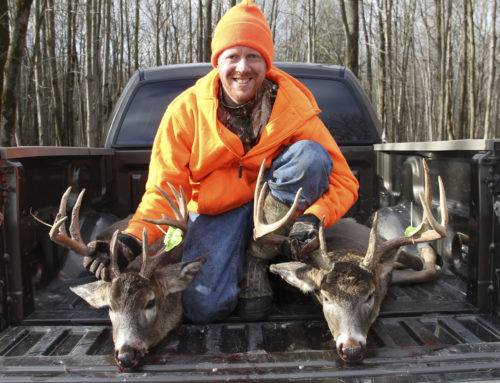Whitetail Deer Hunting – Hunt Like a Pro
But by learning what the pros already know, you can skip the first-timer mistakes and hunt like a pro on your very first trip.
First Things First: Get Your Hunting License
When you want to hunt whitetail deer in Texas, you need to start by getting your hunting license.
Every state is allowed to set their own requirements for hunting licensure and certification, so be sure to research this in advance.
You may also need to complete a hunter safety course as a part of your application.
Get Set Up for a Successful Hunt With the Right Gear
Having great equipment isn’t a substitute for hunting knowledge and skill but it sure doesn’t hurt!
By starting out your hunting ranch adventure with the right gear and equipment, you set yourself up for success.
Weapons and Ammunition
You have a variety of weapons to choose from. Some are easier to learn and use than others (for example, rifle versus bow and arrow).
Be sure the weapon you choose matches your size and strength.
Popular deer hunting weaponry includes rifles, pistols, hand guns, shotguns, crossbows and bow and arrows.
The ammunition you choose should be specific to big game and to deer. Only the right ammunition will allow for a humane, clean kill when that once-in-a-lifetime shot arrives.
Optics and Scopes
Having the right optics can maximize your chances of a successful hunt. For stand hunting, sometimes binoculars will be sufficient.
Always test out the binoculars or optics (spotting scope) you plan to use and get familiar with how they work before your trip.
Avoid the temptation to simply use the scope on your rifle to handle your spotting. It is all too easy to discharge your weapon while scanning and this can cause safety issues as well as hunting violations that are best avoided.
When selecting your binoculars or optics, also consider how well they will serve for night or low light hunting.
Hunting Gear and Apparel
The simplest way to get set up with the right gear and apparel is to shop for a full deer hunter kit.
Many big box outdoors retailers offer kits you can buy that include hat, vest, gloves, knife, game tagging accessories and other basics. Also be sure to get bug and tick spray and earplugs to protect your ears.
It will be very hard to have a successful hunt if you are uncomfortable. You will want to plan to dress in layers so you can adjust to the weather. Deer are most active at dawn and dusk and after nightfall, when it can get cool in many areas.
Be sure to wear footwear that is already broken in and socks with moisture-wicking properties. Also be sure to factor in the possibility of wind and rain when planning your hunting wardrobe.
Camouflage and Orange
Bright orange vests are a requirement, but the exact blaze requirements will vary depending on what state you are in. Be sure to check this in advance. Consider wearing more than the minimum and also investing in a blaze hat for your own safety!
Choose your camouflage for the area and season where you plan to hunt. Don’t forget about camouflage for your skin, including your face and hands (or just wear gloves). Practice applying the camouflage paint in advance since you will need to do this out in the field.
Skinning Supplies
Field dressing and skinning should be done right away to help the carcass cool and minimize “gamey” taste (something which venison is known for).
If you plan to do this yourself, bring along the right tools and supplies. Some hunters like to use a gambrel and pulley system to elevate the carcass for skinning. Even if you don’t plan to do your own skinning, it is important to learn how to field dress your buck right away to avoid the possibility of meat contamination.
If you plan to outsource skinning and meat preparation, be sure to line these services up before your trip so there is no delay once you have the carcass in hand.
Geo-location Gear
The last thing you want to do is head out to bag a deer and get lost! Be sure to learn as much as you can about your hunting location, including whether it is safe to count on having a signal and GPS.
Do you scouting in advance and be sure to bring along detailed maps and photos of the terrain that you can refer to in the field.
Scent Blockers and Calls
The more silent you can be while on the hunt, the better chance you will have of sighting and bagging a buck.
But to a deer, being silent isn’t just about making no sound. It is also about emitting no scent.
To achieve this, you need to block your own scent. Be sure to use only unscented personal care products. Using odor eliminating spray and doe estrous can help to mask your scent and attract a buck.
Some deer hunters swear by deer calls. Three of the most popular are bucks righting (rattles), does in heat (bleating) and rival bucks (grunting). Always match the call you choose to the season of the deer’s calendar.
For example, use the bleat when it is mating season. Use the grunt and/or rattle just prior to mating season (rut).
Choose Your Deer Hunting Strategy
There are four basic deer hunting strategies: stand, still, spot and stalk and driving.
Some hunters adopt one method and stick to it while others alternate depending on the time of year and terrain.
Stand
Still
Spot and Stalk
Driving
Learn How to Track Deer
In many cases, even a shot that seems like a sure thing may not immediately fell the deer. If this happens you will need to know how to track the deer and retrieve it.
When you do find the animal, approach it with care. If it is still alive, quickly and humanely dispatch it.
Then quickly move on to the next steps of the required tagging, field dressing and skinning or carcass transport to the professional who will handle this part of the process for you.
About Austin Trophy Whitetails
Hunt trophy whitetails like a pro at one of our three unparalleled Texas hunting ranch locations in Austin, Gonzalez or Fort McKavett. Individual and corporate experiences are available.
Austin Trophy Whitetails offers whitetail hunting and so much more – fishing, horseback riding, kids activities and fun for the whole family.








Dive straight into the feedback!Login below and you can start commenting using your own user instantly